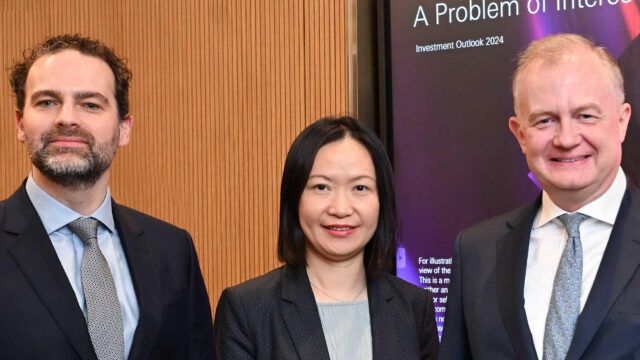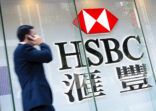HSBC Asset Management (HSBC AM) believes global economies and investment markets face “a problem of interest”. While the US Federal Reserve’s interest rate hikes since March 2022 have “broken inflation, it now risks breaking economic growth,” according to Joseph Little, global chief strategist, HSBC AM.
The asset manger’s assessment of rising recession risk in the West, as well as growth challenges in parts of Asia implies a defensive investment strategy, Little told a media briefing this week.
Economic growth has been resilient in 2023, boosted by strong consumer demand and corporate profits, but the growth outlook looks more difficult in 2024, with “softened labour markets, exhausted consumer savings and disappointing corporate profits”.
“We think a ‘defensive growth’ mind set is warranted for investors at this juncture,” said Little (main picture, right).
“And we think that ‘bonds are back’. There are good opportunities for investors across global fixed income. We see attractive risk-adjusted returns in Western bond markets such as US Treasuries and UK Gilts, and also in securitised debt. Within emerging markets, India and Mexico are some of our preferred bond picks.”
Little also noted that some global credits offer very high yields, similar to levels that stocks have delivered historically. Hence, a “selective approach to high yield credits and private credit such as direct lending makes sense”.
Asian equities shine
In general, HSBC AM believes that Asia will be a relative bright spot in 2024, and the region will continue to be a source of diversification for global investors with several economic themes underway. India again is expected to be one of the world’s fastest growing markets, and Japan will continue its exit from unconventional monetary policy. Meanwhile, growth in China will be cushioned by policy support.
Regional valuations are attractive, foreign investor positioning remains light, while stabilising earnings would likely be the key driver to equity returns in 2024, according to Caroline Yu Maurer, head of China and specialised Asia strategies, HSBC AM.
The outlook remains positive on Taiwan and South Korea amid signs of a gradual turnaround in the semiconductor and technology cycle. India and Asean economies have favourable dynamics, including increased foreign direct investment, positive reform prospects and a more domestically oriented economy.
Despite relatively high valuations in India, they remain reasonable compared with the five-year historical average, as equity investors are focused on selective bottom-up opportunities, said Maurer (main picture, centre).
For China, “recent policy announcements suggest that the government is not complacent about China’s growth outlook,” she said.
Maurer expects policy support in the form of rate cuts and further debt swaps with local governments, helping to deliver GDP growth of around 4.5% next year. “While markets could stay volatile in the near term, the MSCI China Index is now trading at 9.4x 1-year forward P/E suggesting growth concerns and geopolitical outlook are priced in.”
Asian bonds are back on track
2024 is set to be a much better year for Asian credit, supported by global rates reaching their peak, most Asian economies performing well, and China set to benefit from further policy support, according to Geoffrey Lunt, head of Asia investment specialists, HSBC AM.
“With the negative influence of the China real estate funding crisis fading, we believe this is a good time to look again at Asian credit,” he said.
Although the China real estate market continues to dominate headlines, much of the rest of the credit market remains high quality with attractive premiums compared with Western markets, he said.
Fewer inflation and interest rate shocks plus better growth prospects, “should cushion the credit market from defaults and downgrades, while also allowing governments to be supportive with both fiscal and monetary policy”.
Lunt (main picture, left) pointed out that Asian bonds generally yield higher than those in the West, while most investors around the world may be surprised by the high quality and low volatility characteristics – especially in the investment grade market-available in Asian markets.
Meanwhile, selected local bond markets, such as India, are “likely to ride a wave of positive cyclical, secular and technical forces which could lead to strong, uncorrelated returns,” said Lunt.

















